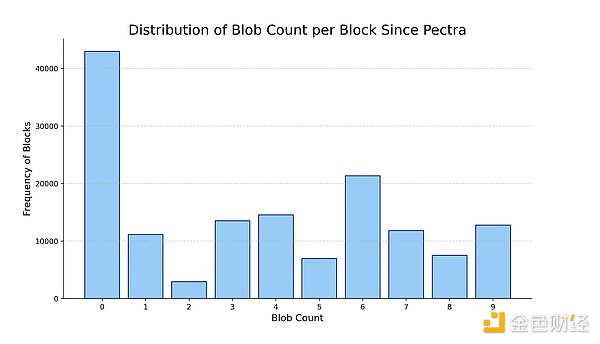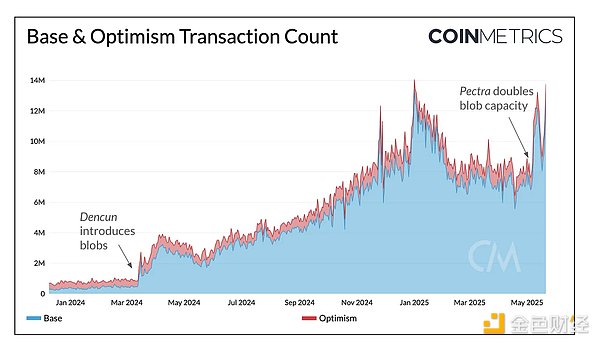Written by Tanay Ved, Coin Metrics
Compiled by: Shan Ouba, Golden Finance
Key Takeaways
- Ethereum’s Pectra upgrade was officially launched on May 7, which includes increasing the maximum effective balance of validators from 32 ETH to 2048 ETH (EIP-7251) and doubling the blob space to support Layer-2 expansion (EIP-7691).
- Currently, more than 11,000 validators have completed the merger, reducing the number of active validators by approximately 16,000, while maintaining the overall amount of staked ETH unchanged, increasing the average staked amount of each validator to approximately 32.4 ETH.
- The number of blobs published to Ethereum increased from ~21,000 to ~28,000, but demand for Rollup usage remained below the new target of 6 blobs per block.
- As costs fall, the number of Layer-2 transactions continues to grow, and the total blob fee is almost zero. If fees rise, it must rely on the increase in Rollup demand for blobs.
introduction
Ethereum's Pectra hard fork was successfully launched on May 7, bringing a series of improvements to validator operations and staking flexibility, improved user experience (UX) through smart accounts, and increased capacity to support Layer-2 expansion. This upgrade includes the implementation of 11 EIPs, which is another milestone since the launch of the beacon chain. It continues to advance Ethereum's roadmap based on the Merge, Shapella, and Dencun stages.
This article analyzes the initial impact of Pectra's launch, focusing on how the increase in Ethereum's maximum effective balance and the doubling of blob space affect the staking mechanism and Layer-2 ecosystem. At the same time, we also tracked and analyzed key Ethereum on-chain indicators related to these changes.
Staking and Validators
One of the main goals of the Pectra upgrade is to optimize the validator operation process and enhance the flexibility of participating in the PoS system. One of the important improvements is EIP-7251, which increases the maximum effective staked balance of validators from 32 ETH to 2048 ETH, which may have a profound impact on the economic structure of the network. This move means that stakers can now "cover positions" for existing validators, or merge multiple validators into one to obtain compound rewards more efficiently.
Increase in maximum effective balance (EIP-7251)
To understand the practical impact of this change, we can look at the specific process of validator merger:
- Update the withdrawal certificate to 0x02 type, indicating that the validator supports merge operations;
- Select the source validator (the validator to be merged) and the target validator (to receive the staked balance);
- Submit a merge request. Once submitted, the source validator will enter the exit queue (which is also used for active exit and other merge operations) because the number of validators that can exit in each epoch is limited;
- When the source validator reaches the withdrawal slot, it will be withdrawn from the active validator set and its effective balance will be transferred to the target validator, thus completing the merger.
This mechanism improves the capital efficiency of the PoS system, allowing large stakers to participate in network maintenance with fewer verification nodes, while also reducing hardware and operation and maintenance costs.

The above chart shows the number of validators that have successfully merged (entered the active validator set) and the total amount of ETH merged. Since the Pectra hard fork went live on May 7, as of May 25, 11,150 validators have merged, merging a total of 359,146 ETH.
Impact on Validators and Staking Economics
Due to the impact of mergers and exits, the total number of active validators has decreased by a net of 16,344 since the Pectra upgrade. This change may also be driven by EIP-7002, which simplifies and speeds up the exit process for validators. Since then, the number of active validators has begun to decouple from the total staked ETH, as more and more stakes are concentrated in a small number of validators with high balances.
The benefits of this centralization are not only reflected in the improved capital efficiency of stakers, but also help reduce network load and peer-to-peer communication pressure - which will become system bottlenecks when the number of validators is large.


Currently, the average stake per validator has risen slightly from ~32 ETH to ~32.4 ETH, but most validators still have an effective staked balance below 128 ETH. As more node operators consolidate their stakes to increase returns, we can expect this average to continue to rise and the distribution structure of validator stakes to change.
Blob expansion and Layer-2 development
Doubled Blob throughput (EIP-7691)
Another core goal of the Pectra upgrade is to further support Layer-2 scalability by doubling the throughput of blobs. Blobs are a low-cost data availability solution introduced in the Dencun upgrade and are a key component in the Ethereum scaling roadmap.
EIP-7691 introduced in Pectra substantially increases the supply of blob space by raising the target number of blobs per block from 3 to 6 (green line) and the upper limit from 6 to 9 (red line). This means that Layer-2 will have greater transaction capacity and lower data availability costs.

After the upgrade, the number of blobs uploaded by Rollup increased from about 21,300 to about 28,000 (4 blobs per block on average), and the blob space used also increased from about 2.7 GB before the upgrade to about 3.4 GB. From the hourly frequency data, the average number of blobs per block is gradually approaching the new target value of 6, indicating that the transaction demand for Layer-2 is growing.
However, blob fees are currently very low as usage has not yet reached the target. Blob distribution data since Pectra went live shows that over 40,000 blocks have not contained any blobs, while around 52,000 blocks have contained 6 or more blobs, which means there is more room for growth.

When the number of blobs submitted per block exceeds the target value (usually occurs during peak demand or network congestion), the blob fee market will be triggered, thereby increasing the blob fee (which also means that Layer-2 costs will increase). In addition, EIP-7623 has also been launched in Pectra, which combats non-optimal data storage methods by increasing the cost of calldata, further encouraging Rollup to use blob space as a more economical data availability solution.
Impact on Layer-2
The increase in Blob supply has a direct impact on the cost of Rollup. The average blob fee has further decreased, making it more predictable and almost free for Rollup projects such as Base, Arbitrum, Optimism, etc. As a result, the total blob fee paid by Layer-2 has dropped to $0.00001 (about 4 gwei). Lower costs mean that Layer-2 has higher profit margins and can also process more transactions on its chain.

Layer-2s like Base and Optimism have seen an increase in throughput, with the number of transactions surging from 8 million to 14 million after the Pectra upgrade. This trend is similar to what happened when blobs were first introduced in the Dencun upgrade in March 2024. If Ethereum wants to extract more value from blob fees, Rollup needs to gradually increase its use of blobs and push them towards the new block cap of 6 blobs per block.

Conclusion
Pectra is an important step towards Ethereum's goal of a universal global settlement layer, reflecting the continued evolution of the protocol. Although not as high-profile as previous upgrades, this feature-rich hard fork introduces greater flexibility and efficiency to the staking ecosystem, making it more future-proof and more suitable for institutional participation, while laying a key foundation for scalability and better user experience (UX).
While early data shows validator integration is ongoing and L2 blob usage is rising, many of the expected economic changes and scaling effects will take time to play out. Pectra may not attract much attention, but it is quietly paving the way for the next phase of Ethereum adoption and growth.
